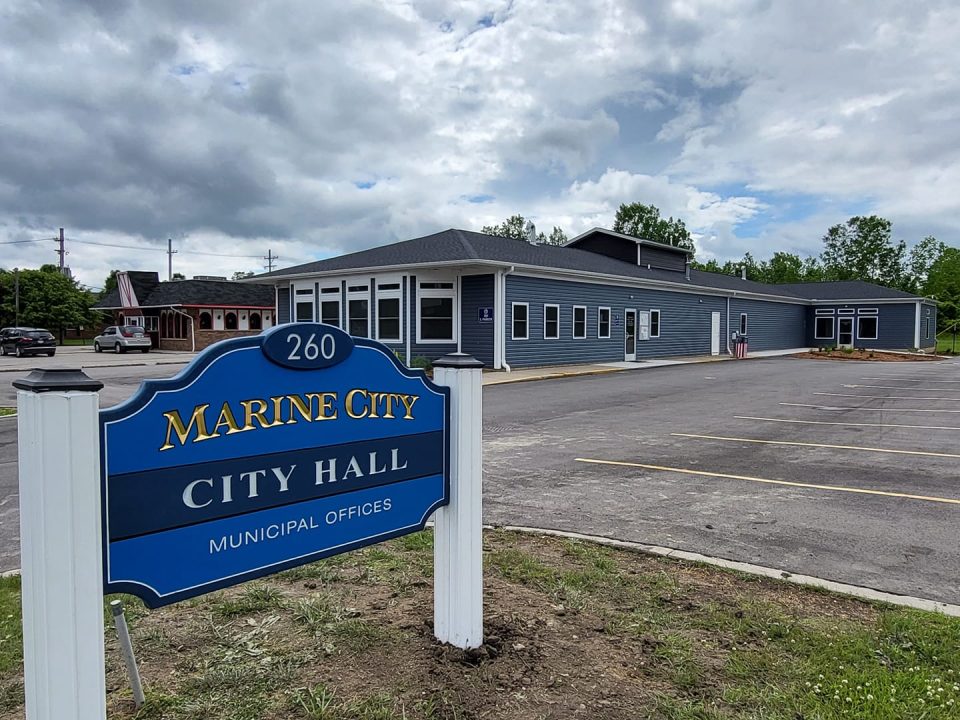Q & A with City Manager Reaves explains reasons
By Barb Pert Templeton
When your infrastructure is more than 80-years-old and the work to keep it up and running isn’t done it can reach end of life status quickly putting water and sewer service in jeopardy.
Unfortunately, unless people have no drinking or bathing water or sewage waste stops leaving their home, most don’t even think the infrastructure, said Marine City Manager Michael Reaves.

“Our underground infrastructure and our above ground infrastructure. for both the water plant and wastewater plant, have many pieces that are literally hanging on,” Reaves said in a recent email. “We face failure of some components if we do not take some immediate action to fix our issues – hence the urgency in doing this the right way -for the right reasons.”
“It is unfortunate but the time to start this work was literally 20 + years ago – now we are behind in the process, and we must address these issues – or face even larger issues,” Reaves added.
To tackle the issue the city has made it an agenda item at multiple commission meetings, hosted presentations, placed packets of information on the city website, held and also held a town hall and a public hearing on the topic.
At the city commission’s most recent meeting on Nov. 20 the commission adopted Ordinance 25-004 – Water/Sewer Rates second reading/adoption. Commissioner Sean O’Brien was absent from the meeting.
“No one is ever happy about an increase in water or sewer rates; and everyone thinks their water bill is the highest of anyone else’s – I get that. But there is a cost for clean water and sanitary waste processing and the related infrastructure. We have been and will continue to be very transparent in what we are doing and why.”
Marine City Manager Michael Reaves
The new rates represent a 56.8% increase for users although they won’t go into effect until Jan. 1. Mayor Pro Tem Lisa Hendrick had previously pointed out that increase would be approximately $75.12 per quarter or about $25 per month. She added that the increase is for the ready-to-serve fees and the debt service fees, so the water rate itself really wasn’t going up.
“It’s going to jack my bill up, the last one was $132 and it’s going to go up to $207 – so that’s a jump for everybody,” Hendrick explained at a Nov. 6 meeting of the city commission.
Blue Water Healthy Living caught up with Reaves via email to pose some additional questions about the new rates to perhaps make things clearer for those affected by the increase.

Marine City Manager Michael Reaves.
Blue Water Healthy Living: What’s the average amount of gallons of water a household uses in a month?
City Manager Michael Reaves: This is a very hard question because there are so many different variables – There really is no average water bill. The water commodity cost – how much each person used can be controlled and reduced – but even if you used “no water whatsoever” -there would still be a water bill as the other charges are still in effect. We must pay for the infrastructure needs, operational needs, etc. The cost of the commodity of water is only one factor in the equation.
BWHL: What about businesses – like restaurants – will they notice a significant hike in their quarterly bills?
Reaves: Debt Service and Ready-to-Serve charges are based on meter size therefore businesses with larger meters will see an increase in their billing for those charges, in addition to any usage-based increases.
BWHL: New rate begins Jan. 1 but when will those first quarterly bills be mailed out to users and due for full payment?
Reaves: The city is divided into three sections that are billed quarterly. Bills mailed in January will be due in February, they will have the full DWSRF and RTS charges added but the commodity charge will be at the former rate as the usage months are Oct, Nov, Dec. Bills mailed in February and March will have the full DWSRF and RTS charges but will be billed at a blended commodity rate for the usage months. Bills sent in April and those going forward will have the full adopted water/sewer charges.
BWHL: Can user’s setup a payment plan and maybe pay a little each month instead of one big bill every three months?
Reaves: Yes, users may set up payment plans if they will not have their bill paid by the shut off date. Users may also make payments on their accounts in any increment, at any time.
BWHL: What’s the time frame for shut-off notices for non-payment – example 30 or 45 days past due?
Reaves: Approximately 30 days past due; users are sent notices with their shut off date listed.
BWHL: Is there a late fee?
Reaves: Yes.
BWHL: What is it?
Reaves: A 10% late fee of the total amount due.
BWHL: If service is shut-off is there a charge to have it reinstated?
Reaves: Yes.
BWHL: How is that amount arrived at?
Reaves: Per ordinance it’s $30 turn off/on.
BWHL: How long will the new rates be in place for these services in Marine City?
Reaves: For the foreseeable future going forward. See below for explanation.
BWHL: Can the rate possibly be reduced once the projects are completed and the system is up and running?
Reaves: The Debt service portion would drop-off – but realistically after one project ends, another one generally begins. You are usually always working on your infrastructure in one way or another.
BWHL: What’s been the biggest challenge for you, as city manager, in getting this all sorted out?
Reaves: We really took our time and brought in professional assistance of the Michigan Rural Water Association for both water and sewer sides of the issue. We did an extensive deep dive into all facets of these charges. We were able to keep the commodity charges flat (what you use you pay for) but the back end or infrastructure costs had to be raised. These costs were exceedingly low for multiple years and now the state of MI flagged our audit for this purpose. We do not have enough in ready-to-serve costs accounts to make or pay for any infrastructure improvements.
“No one is ever happy about an increase in water or sewer rates; and everyone thinks their water bill is the highest of anyone else’s – I get that. But there is a cost for clean water and sanitary waste processing and the related infrastructure,” Reaves said. “We have been and will continue to be very transparent in what we are doing and why.”



